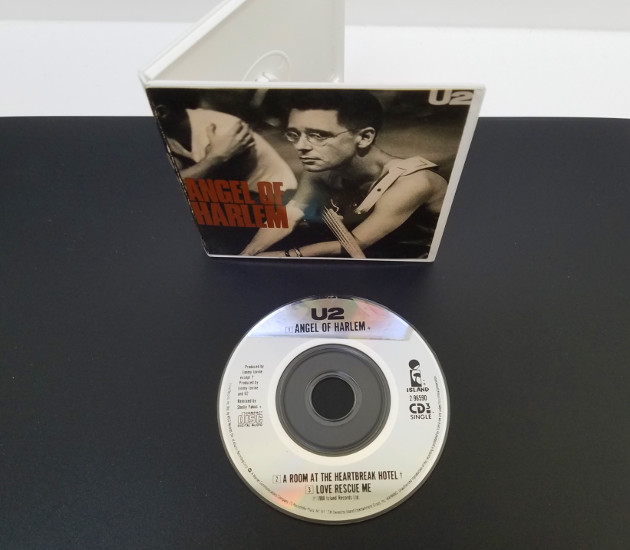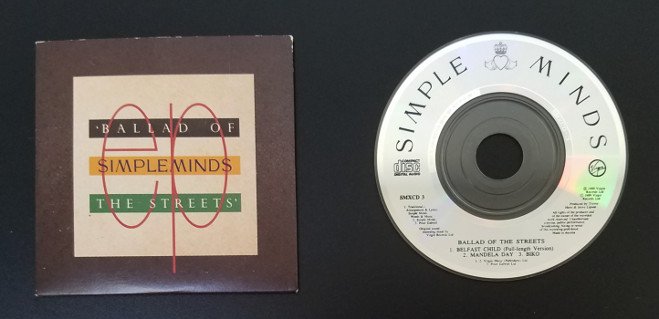In 1987, Sony and Philips, the developers of the original compact disc, came up with another idea.
"Hey," they probably figured, "since the CD is like a long-playing vinyl album, why not have a smaller CD that you could use for singles, like the 45 rpm record?"
And that was the actual logic cited in a brief article in the Wall Street Journal on December 10, 1987, "The prerecorded three-inch digital CDs most likely will be priced to be competitive with the existing 45-rpm 'singles', [a Philips] spokeswoman said."
Well, first they forgot their history. The 45 rpm record hung around so long because RCA didn't want to join in with its archrival. CBS had an unexpectedly incredible amount of success with the LP, which it developed and brought to market in 1948. RCA was jealous of its number-one position in electronics and entertainment.
Second, some older CD players couldn't play the newer, smaller discs without an adapter. Sony did produce a portable player for the 3-inch (diameter) discs, the D-88, but it didn't sell well.
Finally, better portable CD players were developed. The newer players were more durable, lighter, and didn't ravenously consume batteries on an hourly basis. Ultimately, it appears, consumers didn't see the need for a smaller CD format.
Some companies had doubts about the format from the very start. "A spokesman for Polygram B.V., the holding company for some well-known major recording labels...and a unit of Philips, said the recording industry isn't enthusiastic about this format. He said he doubted prerecorded three-inch digital CDs could be sold as inexpensively as a traditional 45-rpm single." (Wall Street Journal, December 10, 1987)

Production began in 1988. Through the pages of Billboard, one can trace the ascent and the rapid fall of the format. The first half of 1988 seemed to be devoted to endless arguments about how best to package the CD-3, how to price it, and what to put on it. The question of packaging never seemed to be fully settled. Compare the U2 plastic case shown at left with the paper sleeve of the Simple Minds CD-3 shown toward the bottom of this page.
At the time, standard 5-inch CDs cost around $15. That price was thought to be too high for younger consumers, especially teenagers. Some labels promoted the idea of having a smaller, much cheaper CD for younger buyers. Whether the CD-3 was a solution looking for a problem to solve is hard to tell. There was a lot of enthusiasm among some record labels for the format. Others had doubts, noting that the tape-cassette single had taken off in the previous two years and would be a direct competitor to the CD-3.
Nonetheless, the format was rolled out. A Billboard headline in a special section on September 24, 1988 proclaimed, CD-3 Makes Strong Showing in Channel; Labels Vow Commitment to Tiny Format. It was estimated that more than 200 CD-3s were available by then.
Just a month later, Billboard reported that record labels were complaining about small profit margins on CD-3s. Three configurations had emerged: a single with two songs for about $3, a 3-to-4-song "maxi-single" for about $4, and a "mini-LP" with multiple tracks for about $5. These prices were intended to entice younger buyers on limited budgets, and were one-third or less than the price of a CD album.
Those complaints about margins were the first sign of trouble. By the following April, plans were underway for singles using the standard 5-inch CD format. Billboard reporter Geoff Mayfield wrote, "Can a 5-inch CD single succeed where the 3-inch CD single has not?" (Billboard, April 1, 1989) Apparently so: by 1991, articles in Billboard described how the single and dance-mix markets were being taken over by CD-5 singles. In 1995, several major labels reduced the price of their CD-5 singles to firmly establish them as the replacement for 12-inch-format analog disc singles. (Billboard, September 2, 1991 and September 21, 1995)
Back to 1989: two months after Billboard reported that record labels were having trouble making a profit on CD-3s, the front-page headline was, Most Labels Take Five on 3-Inch CD. Only CBS was issuing new CD-3 releases by that time. (Billboard, June 3, 1989)
By July, at least five major retail chains had stopped stocking CD-3s, including the influential Tower Records chain. The VP of purchasing for the Hastings chain said of the CD-3, "It doesn't fit anywhere. So many players won't accept it, and the consumer wasn't behind it." The VP for another group of record stores summed it up: "We just did not sell them". Consumers appeared to prefer cassette singles, according to the retailers, and lack of a standard way of packaging CD-3s were said to lead to confusion among customers and difficulty in stocking the product. (Billboard, July 7, 1989)
CBS hung on until October: CD-3 Loses Last Major As CBS Bails Out was the front-page headline in Billboard on October 27. So much for that "commitment to the tiny format".
Other Billboard articles indicated that there was more interest in Europe. And, with the CD-3 being a sluggish seller in the United States, there were some leftover stocks for some time. I didn't really begin collecting 3-inch CDs until 1990 and was able to find at least a few. I was blissfully unaware of all those Billboard articles at the time. I ended up with 20 CD-3s (one is a gift), listed below. It's hard to find an accurate count of the total number of CD-3 releases that were issued, but it appears that there were around 250 of them.

- A Touch of DMP, Various Artists (said to be the very first CD-3 release in 1987)
- Akai Sweet Pea, Seiko Matsuda (from Japan, a gift from Eric Holeman)
- Angel of Harlem, U2
- Ballad of the Streets (Belfast Child), Simple Minds (pictured)
- Crimson and Clover, Tommy James and the Shondells
- Dance to the Music, Sly and the Family Stone
- Don't You Forget about Me (live), Simple Minds
- Everlasting Love, Howard Jones
- Get Ready, Rare Earth
- Lullaby, The Cure
- Mexican Radio, Wall of Voodoo
- Motown Dance Party, Various Artists
- My Generation, The Who
- Our Lips Are Sealed, The Go-Go's
- Radar Love, Golden Earring
- Roll with It, Steve Winwood
- Round & Remix, New Order
- Run Like Hell, Pink Floyd
- The Stand, The Alarm
- The Year of the Cat, Al Stewart
The physical format re-appeared later as CDs containing data, for recordable CDs (CD-Rs), and for some DVD camcorders. In 2020, they could still be found on Amazon, though it took some searching to find.
Oakland, California
E-mail: Please see the Contact Information page.
